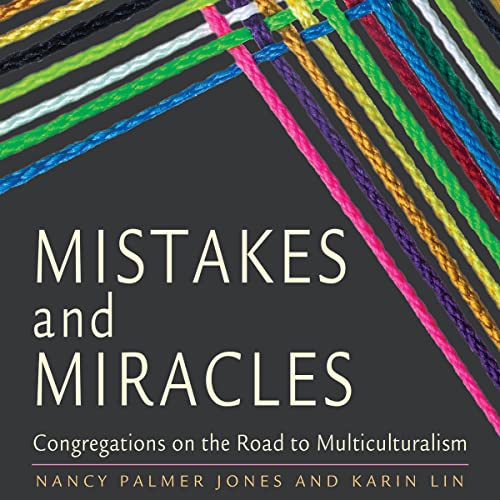
- This event has passed.
Book Discussion: Mistakes and Miracles

Mistakes and Miracles: Congregations on the Road to Multiculturalism
light lunch will be served
1. Read Chapter Two, “Common Threads,”
What calls Unitarian Universalists to create multicultural, antiracist Beloved Community? What do congregations need when they embark on this journey? What common threads run through their stories?
Nancy Palmer Jones and Karin Lin—a white minister and a lay person of color—share how five diverse congregations encounter frustrations and disappointments, as well as hope and wonder, once they commit to the journey. Mistakes abound. Miracles of transformation and joy emerge too. Extensively researched and thoughtfully written—with reflection questions at the end of each chapter—Mistakes and Miracles: Congregations on the Road to Multiculturalism will guide listeners to apply these stories to their own communities, develop next steps, and renew their commitment to this hard but meaningful work.
Suzanne’s Summary:
Common Threads
Mistakes and Miracles: Congregations on the Road to Multiculturalism
by Nancy Palmer Jones and Karen Lin (2019) Skinner House Books pp 30-32
In the book Mistakes and Miracles, they ask the following questions for congregations to consider to create multicultural, anti-racist communities –
1) Who has power in the here and now and who doesn’t?
2) Who benefits and who doesn’t from hierarchical systems created long before we current strugglers were born?
“Our Common Threads include most of the shared elements from the lists in earlier resources, along with some of our own. No one congregation embodies all of these Common Threads, and congregations almost never implement them fully. The Common Threads do not constitute a step-by-step-to-do-list. Congregations can enter into this work at multiple points; they can pick up one or more of these elements at any stage in their development. We witness most of these Common Threads. In sections that follow, we look more closely at each one.
* Intentionality: congregations ground their journey in an overarching goal or sense of call, made explicit in their mission and vision.
*Relationships, Relationships, Relationships: Building and tending to healthy relationships within the congregation and beyond are central to the work.
* Leadership That’s Diverse, Committed, and Collaborative: Ministers, staff, and lay leaders are passionate champions for the multicultural, antiracist mission. Whenever possible, they represent a wide range of identities.
* Education for Multicultural Competencies and Collaboratives: Ministers staff and lay leaders are passionate champions for the multicultural, antiracist missions. Whenever possible, they represent a wide range of identities.
* Education for Multicultural Competencies and Antiracism: Through classes and trainings that speak to different generations, congregants can name the impact of white supremacy culture and other oppressive systems of power and privilege. They explore the congregation’s history and the wider community in which they dwell in order to draw on strengths and reconcile mistakes from the past.
* Institutionalized Structures That Support the Multicultural, Antiracist Mission: Congregations adapt their governance and committee structures to make them more inclusive. They work to eliminate barriers to participation in leadership.
* Multicultural is Multigenerational: Children, youth, young adults, and adults workshop, learn, and grow together, honoring their different styles and expectations of family life across racial, ethnic, and generational differences.
* Worship that Speaks to the Heart and That Centers Diverse Voices, Styles, and Cultures: Worship in these congregations touches congregants’ hearts, bodies, and spirits as well as their minds. It includes music language, and art from many cultural sources. Such inclusion is authentic and accountable because the congregation has relationships with people whose cultures are represented.
*Social Justice and Community Engagement: The congregation works in partnership and solidarity with traditionally marginalized groups at the local, state and national levels for justice and equity for all. Congregants – especially those from the dominant culture- know how to follow leaders of color as well as how to use their own power appropriately for change that benefits those at the margins.
*Adaptability and Entrepreneurship: The work of creating multicultural, antiracist Beloved Community keeps evolving. These congregations adapt their initial plans to meet changing times and contexts. They develop a gift for improvisation and joy. They are on the journey for the long haul.
* A Willingness to Take Risks and to Feel Uncomfortable: Taking risks – especially risking ‘failure’ – creates discomfort in most congregational systems. Yet in the work of building multicultural, antiracist Beloved Community, if some folks are not uncomfortable, then the congregation or community may not be moving into the areas that need the deepest change.
* Patience, Perseverance, Courage, and Humility: This work is messy, and it never ends. Well-trained and well-intentioned people will keep making mistakes. Conflict is inevitable. Patience, Perseverance, courage, and humility are prime habits of the heart in building multicultural, antiracist Beloved Community.
* A Palpable Aliveness and Love: Congregations on this journey have a sense of aliveness and enthusiasm for the work. Everyone has the chance to feel more whole and ‘seen’ in such communities. The spirit of love is palpable in the congregations that commit to this soul work.
All of these Common Threads are easier to grasp through story, example, and experimentation than through lecture and description. The following sections draw on wisdom and examples from a wide range of sources as well as on the lived experiences of the congregations we study.”
